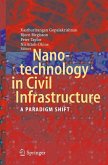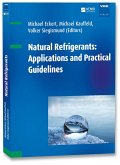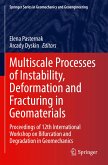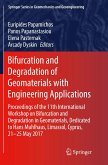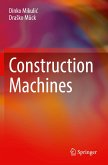Advances in Composites Manufacturing and Applications
Proceedings of the American Society for Composites 39th Technical Conference, Volume 6
Herausgegeben:Vashisth, Aniruddh; Wang, Yeqing
Advances in Composites Manufacturing and Applications
Proceedings of the American Society for Composites 39th Technical Conference, Volume 6
Herausgegeben:Vashisth, Aniruddh; Wang, Yeqing
- Gebundenes Buch
- Merkliste
- Auf die Merkliste
- Bewerten Bewerten
- Teilen
- Produkt teilen
- Produkterinnerung
- Produkterinnerung
This book presents the proceedings of the American Society for Composites 39th Technical Conference. This volume, the sixth of six volumes, presents a diverse collection of research papers on the manufacturing, modeling, and application of composite materials. This volume covers topics like additive manufacturing, process modeling, and advanced technologies, the volume explores innovative solutions to enhance material properties, optimize production methods, and improve structural performance. The proceedings highlight key advancements in additive manufacturing methods for composites,…mehr
Andere Kunden interessierten sich auch für
![Nanotechnology in Civil Infrastructure Nanotechnology in Civil Infrastructure]() Nanotechnology in Civil Infrastructure77,99 €
Nanotechnology in Civil Infrastructure77,99 €![Construction Machines Construction Machines]() Dinko MikulicConstruction Machines106,99 €
Dinko MikulicConstruction Machines106,99 €![Natural Refrigerants: Applications and Practical Guidelines Natural Refrigerants: Applications and Practical Guidelines]() Natural Refrigerants: Applications and Practical Guidelines59,00 €
Natural Refrigerants: Applications and Practical Guidelines59,00 €![Multiscale Processes of Instability, Deformation and Fracturing in Geomaterials Multiscale Processes of Instability, Deformation and Fracturing in Geomaterials]() Multiscale Processes of Instability, Deformation and Fracturing in Geomaterials166,99 €
Multiscale Processes of Instability, Deformation and Fracturing in Geomaterials166,99 €![Multiscale Processes of Instability, Deformation and Fracturing in Geomaterials Multiscale Processes of Instability, Deformation and Fracturing in Geomaterials]() Multiscale Processes of Instability, Deformation and Fracturing in Geomaterials166,99 €
Multiscale Processes of Instability, Deformation and Fracturing in Geomaterials166,99 €![Bifurcation and Degradation of Geomaterials with Engineering Applications Bifurcation and Degradation of Geomaterials with Engineering Applications]() Bifurcation and Degradation of Geomaterials with Engineering Applications151,99 €
Bifurcation and Degradation of Geomaterials with Engineering Applications151,99 €![Construction Machines Construction Machines]() Dinko MikulicConstruction Machines76,99 €
Dinko MikulicConstruction Machines76,99 €-
-
-
This book presents the proceedings of the American Society for Composites 39th Technical Conference. This volume, the sixth of six volumes, presents a diverse collection of research papers on the manufacturing, modeling, and application of composite materials. This volume covers topics like additive manufacturing, process modeling, and advanced technologies, the volume explores innovative solutions to enhance material properties, optimize production methods, and improve structural performance. The proceedings highlight key advancements in additive manufacturing methods for composites, including continuous fibers and novel materials (thermoplastics, ceramics, and frontal polymers). Process modeling techniques are covered to address critical issues such as curing, wrinkle formation, and microstructural defects. Advanced manufacturing technologies and their validation are also discussed, focusing on improving composite performance. The civil applications of composites and studies under the NASA HiCAM program are also explored, showcasing the growing relevance of composites in various engineering fields.
Produktdetails
- Produktdetails
- Proceedings of the American Society for Composites Annual Technical Conferences
- Verlag: Springer / Springer Nature Switzerland / Springer, Berlin
- Artikelnr. des Verlages: 89552425, 978-3-032-05223-0
- Seitenzahl: 292
- Erscheinungstermin: 13. Dezember 2025
- Englisch
- Abmessung: 235mm x 155mm
- ISBN-13: 9783032052230
- ISBN-10: 3032052238
- Artikelnr.: 75134850
- Herstellerkennzeichnung
- Springer-Verlag GmbH
- Tiergartenstr. 17
- 69121 Heidelberg
- ProductSafety@springernature.com
- Proceedings of the American Society for Composites Annual Technical Conferences
- Verlag: Springer / Springer Nature Switzerland / Springer, Berlin
- Artikelnr. des Verlages: 89552425, 978-3-032-05223-0
- Seitenzahl: 292
- Erscheinungstermin: 13. Dezember 2025
- Englisch
- Abmessung: 235mm x 155mm
- ISBN-13: 9783032052230
- ISBN-10: 3032052238
- Artikelnr.: 75134850
- Herstellerkennzeichnung
- Springer-Verlag GmbH
- Tiergartenstr. 17
- 69121 Heidelberg
- ProductSafety@springernature.com
Aniruddh Vashisth is an Assistant Professor at the University of Washington, Seattle in the Mechanical Engineering Department. Aniruddh's main areas of interest in Advanced Composite Materials are sustainable polymers and their composites, energy-efficient manufacturing, and processing-structure-property relationship. His group focuses on understanding the underlying physics of advanced composites using a closely coupled experimental and theoretical approach. He received the ASC Young Composites Researcher Award in 2024. DoE, DoD, NSF, and industry fund his research. Yeqing Wang is an Assistant Professor in the Department of Mechanical and Aerospace Engineering at Syracuse University. His research interests encompass the mechanics of composite materials and structures, multifunctional composites, advanced composite manufacturing, and lightning strike protection of composites. He received the Ralph E. Powe Junior Faculty Enhancement Award in 2020 and the Best Paper Award at the 2012 American Society for Composites Technical Conference. He is a voting member of the ASME Structures & Materials Technical Committee and a Senior Member of AIAA. NSF and NASA fund his current research.
Part 1: Composites in Civil Applications.- Chapter 1: A Methodology Proposal for the Modelling, Analysis and Optimization of HAWT Blades Used in theNnorthern Region of Baja California, Mexico.- Chapter 2: Effect of Edge Gluing on Failure Modes in Notched Cross-Laminated Timber Under Bending Loads.- Chapter 3: Performance of Cross-Laminated-Timber Against Rolling Shear Failure due to Out-of-Plane Bending.- Chapter 4: Shear Connection Analysis in G-FRP Composite Beams: Experimental and FEM Study.- Part 2: Manufacturing - Additive.- Chapter 5: Additive Continuous Tows Preform for Fiber Angle Optimized Composite Tube.- Chapter 6: Additive Manufacturing of Continuous Carbon Fiber Thermoset Composites Based on Frontal Polymerization.- Chapter 7: Additive Manufacturing of Continuous Fiber Reinforced Thermoplastic Composite Grid Stiffened Panels.- Chapter 8: Additively Manufactured Composites: Pioneering Customisable Tow-Preg Filaments to Deliver Tailored Material Properties.- Chapter 9: Advancing Additively Manufactured Composite Structural Joints Testing with Discrete Computational Modeling and Digital Twins.- Chapter 10: Exploring 3D-Printed Ceramics: A Study in Nano-Reinforced Composites.- Chapter 11: Extrusion-Based Additive Manufacturing of Large Composite Structures for Aerospace Applications.- Chapter 12: Fused Deposition Modeling (FDM) of PolyEtherKetoneKetone (PEKK): Tailoring Tensile Strength via Process Parameter Optimization.- Chapter 13: Improved Deposition Rates in Additive Manufacturing of Commingled Tow-Based Continuous Fiber-Reinforced Composites via Alternating Tow Positioning.- Chapter 14: Preparing Lattice Structures Using Continuous Carbon Fibers and Thermoset Composites.- Part 3: Manufacturing - Process Modeling.- Chapter 15: Assessing Micro-Void Formation at the Tips of Fibers within the Microstructure of Additively Manufactured Polymer Composite Bead.- Chapter 16: Curing Simulation of Composites through 1D Multi-Field Finite Element Models.- Chapter 17: Leveraging Profilometry-Based Inspection Data to Capture Green-State Laminate Thickness of Automated Fiber Placement Structures.- Chapter 18: Numerical Methodology for Wrinkling Prediction in Automated Fiber Placement.- Chapter 19: Wrinkle Deformation of Curved Prepreg Slit-Tapes Tow-Steered Laminates During Automated Fiber Placement.- Part 4: Manufacturing - Technology.- Chapter 20: Design Optimization and Analysis Validation of Complex Composite Parts Using Fiber Patch Placement.- Chapter 21: Plasma Treatment of Aramid, Glass, and Flax Fabrics to Increase the Mechanical Properties of FRP Composites.- Chapter 22: Utilizing Through Thickness Frontal Polymerization for Rapid and Continuous Lamination of Carbon Fiber Beams.- Part 5: NASA HiCAM Program.- Chapter 23: Analysis of Crack Propagation Transients in Accelerated Fatigue Characterization of Adhesives.- Chapter 24: Characterization of Low-Velocity Impact Damage in Toughened Non-Crimp Fabric Laminates.- Chapter 25: Design for Manufacturing of Structures with Automated Fiber Placement via Integration of Analysis and Process Planning.
Part 1: Composites in Civil Applications.- Chapter 1: A Methodology Proposal for the Modelling, Analysis and Optimization of HAWT Blades Used in theNnorthern Region of Baja California, Mexico.- Chapter 2: Effect of Edge Gluing on Failure Modes in Notched Cross-Laminated Timber Under Bending Loads.- Chapter 3: Performance of Cross-Laminated-Timber Against Rolling Shear Failure due to Out-of-Plane Bending.- Chapter 4: Shear Connection Analysis in G-FRP Composite Beams: Experimental and FEM Study.- Part 2: Manufacturing - Additive.- Chapter 5: Additive Continuous Tows Preform for Fiber Angle Optimized Composite Tube.- Chapter 6: Additive Manufacturing of Continuous Carbon Fiber Thermoset Composites Based on Frontal Polymerization.- Chapter 7: Additive Manufacturing of Continuous Fiber Reinforced Thermoplastic Composite Grid Stiffened Panels.- Chapter 8: Additively Manufactured Composites: Pioneering Customisable Tow-Preg Filaments to Deliver Tailored Material Properties.- Chapter 9: Advancing Additively Manufactured Composite Structural Joints Testing with Discrete Computational Modeling and Digital Twins.- Chapter 10: Exploring 3D-Printed Ceramics: A Study in Nano-Reinforced Composites.- Chapter 11: Extrusion-Based Additive Manufacturing of Large Composite Structures for Aerospace Applications.- Chapter 12: Fused Deposition Modeling (FDM) of PolyEtherKetoneKetone (PEKK): Tailoring Tensile Strength via Process Parameter Optimization.- Chapter 13: Improved Deposition Rates in Additive Manufacturing of Commingled Tow-Based Continuous Fiber-Reinforced Composites via Alternating Tow Positioning.- Chapter 14: Preparing Lattice Structures Using Continuous Carbon Fibers and Thermoset Composites.- Part 3: Manufacturing - Process Modeling.- Chapter 15: Assessing Micro-Void Formation at the Tips of Fibers within the Microstructure of Additively Manufactured Polymer Composite Bead.- Chapter 16: Curing Simulation of Composites through 1D Multi-Field Finite Element Models.- Chapter 17: Leveraging Profilometry-Based Inspection Data to Capture Green-State Laminate Thickness of Automated Fiber Placement Structures.- Chapter 18: Numerical Methodology for Wrinkling Prediction in Automated Fiber Placement.- Chapter 19: Wrinkle Deformation of Curved Prepreg Slit-Tapes Tow-Steered Laminates During Automated Fiber Placement.- Part 4: Manufacturing - Technology.- Chapter 20: Design Optimization and Analysis Validation of Complex Composite Parts Using Fiber Patch Placement.- Chapter 21: Plasma Treatment of Aramid, Glass, and Flax Fabrics to Increase the Mechanical Properties of FRP Composites.- Chapter 22: Utilizing Through Thickness Frontal Polymerization for Rapid and Continuous Lamination of Carbon Fiber Beams.- Part 5: NASA HiCAM Program.- Chapter 23: Analysis of Crack Propagation Transients in Accelerated Fatigue Characterization of Adhesives.- Chapter 24: Characterization of Low-Velocity Impact Damage in Toughened Non-Crimp Fabric Laminates.- Chapter 25: Design for Manufacturing of Structures with Automated Fiber Placement via Integration of Analysis and Process Planning.


